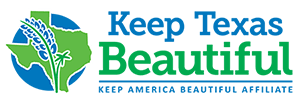It’s almost time for the 2018 Governor’s Community Achievement Awards! Every year, 10 winning communities share $2 million in landscape awards in recognition of their efforts to keep their communities beautiful. For more than 30 years, these prestigious awards have been awarded to deserving communities across the state of Texas. This year, the application will open on January 1, 2018. However, to allow applicants time to compile needed information and resources, we have decided to release the application questions early (please note: the application will still not be available to be completed until January 1). The full list of questions is below:
Community Leadership and Coordination – 12 Points
1. Describe your community and its specific characteristics (i.e., brief history, demographics.)
2. Is your community associated with any state or national organization(s) related to litter prevention, beautification, community improvement and/or waste reduction?
3. How are your community improvement programs funded? Include annual operating budget, matching grants, foundation grants, government funding and how funding is obtained.
4. Describe staff support for your community improvement programs. Are they run by volunteers and/or full time or part-time paid staff?
5. Describe any training that is provided to the instructors/managers of your community improvement programs.
Public Awareness – 12 Points
1. Describe how your community made the general public aware of your community improvement programs through the use of media, speeches, social media, Web sites, events, workshops, bulletin boards, technology and/or printed materials. List measurable results.
2. How has your community worked to promote the Don’t Mess with Texas® campaign?
3. Describe community awards and recognition programs. Note awards given and awards received.
Education – 12 Points
1. What educational events, projects or programs are available in your community to teach the general public about recycling, waste reduction, litter prevention or beautification issues? List impact and measurable results.
2. What types of environmental education do your community’s schools offer? Describe what kind and how many programs or special events are offered for youth and your community’s involvement. Include any youth, preschool, elementary, secondary, college and university programs in your community.
3. How do your schools use environmental curricula such as Project Wild, Waste in Place, Project Learning Tree, and/or other educational activities?
Beautification and Community Improvement – 12 Points
1. Describe beautification efforts such as tree and flower planting, native or adaptive landscaping, and landscape maintenance. Include data on plantings and impact.
2. How has your city worked to improve the appearance of your community, instill pride, and provide a positive impact on the economic development and prosperity of your community?
3. How many Adopt-a-Highway miles does your city maintain? Exempting those locations already identified in your city’s Municipal Maintenance Agreement with TxDOT, does your city perform mowing or maintenance activities on any additional state rights of way?
Litter Prevention and Cleanup – 12 Points
1. Does your community conduct any type of study/survey to determine a litter problem?
2. Uncovered trucks, construction sites, motor vehicles and pedestrians are the primary sources of the litter found on roadways in and out of cities. Describe how your community specifically addresses these issues.
3. Was your community involved with any litter prevention programs, such as Earth Day, Don’t Mess with Texas Trash-Off, World Oceans Day, Adopt-a-Highway, or America Recycles Day?
4. What was the impact on the environment and/or the public’s attitude toward litter prevention and cleanup based on your litter prevention programs?
5. List the community cleanups you held and measurable results of those events.
Solid Waste Management – 12 Points
1. Describe your community’s involvement in solid waste management, including work with local waste haulers, businesses, civic groups and citizens.
2. Describe how your community has supported source reduction, recycling, reuse and composting to divert from landfill space. List measurable results if applicable.
Litter Law and Illegal Dumping Enforcement – 12 Points
1. Describe community efforts to educate and work with law enforcement personnel (city, county or state) to review and enforce local and state litter laws, including litter abatement and/or illegal dumping.
2. Describe community efforts to reduce nuisance issues such as graffiti, grass and weed violations, dilapidated structures, junked cars and similar issues.
Conclusion – 6 Points
1. Explain how your community’s overall environmental efforts have made your community a better place to live, work and play.
Thank you for your interest in the 2018 Governor’s Community Achievement Awards! The online application will be released to be completed on January 1 here. After January 1, applicants will have until February 6, 2018 to complete the application and all materials.




